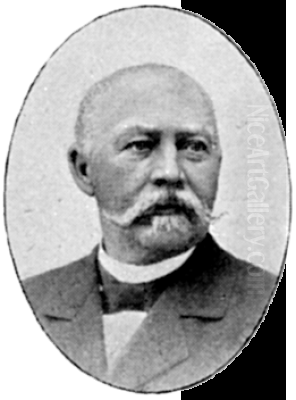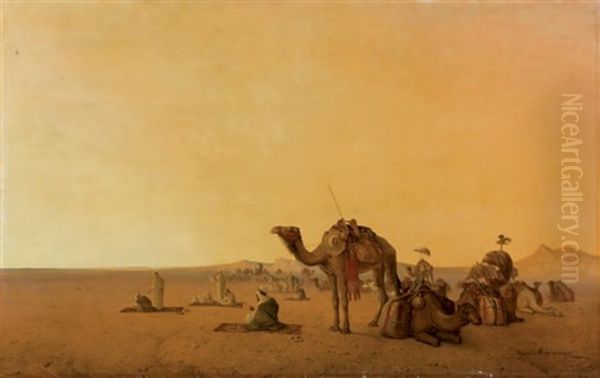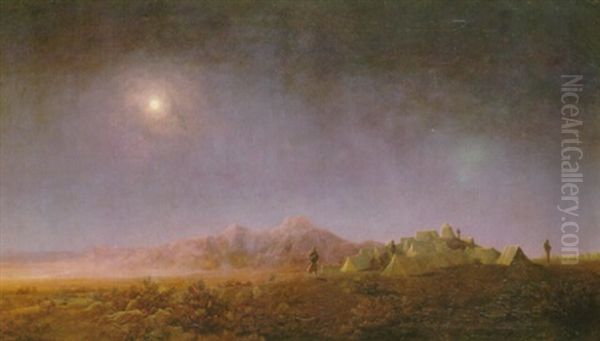
Henrik August Ankarcrona stands as a notable, if sometimes overlooked, figure in the panorama of 19th-century European art. A Swedish national, born in 1831 and passing away in 1917, Ankarcrona carved a niche for himself primarily as an Orientalist painter. His life and work offer a fascinating glimpse into the era's artistic currents, the European fascination with the "Orient," and the intersection of military life with artistic pursuits. His canvases, often depicting scenes from North Africa, particularly Algeria, capture the landscapes, peoples, and perceived drama of a world that held immense allure for Western audiences of his time.
Early Life and Artistic Awakening
Born into a noble Swedish family at Runsa manor, near Uppsala, Henrik August Ankarcrona's early life was steeped in the traditions of his class. His path initially led him towards a military career, a common trajectory for young men of his standing. He attended a military academy, where he would have received rigorous training. However, alongside his martial education, a passion for the arts began to bloom. Ankarcrona dedicated himself to learning painting and drawing, skills that would later define his professional life.
This dual interest in military affairs and artistic expression was not uncommon in the 19th century. Many officers, such as the French painter Horace Vernet, who also depicted North African scenes, or the British officer-artist William Simpson, known for his Crimean War sketches, found that their military postings provided unique opportunities for observation and artistic documentation. For Ankarcrona, this combination would prove formative, particularly when his service took him far from the familiar landscapes of Sweden. The precise details of his early artistic training in Sweden are not extensively documented, but it is plausible he sought instruction from established Swedish artists or within academic circles before his more defining experiences abroad.
The Algerian Experience: A Crucible for Orientalist Art

A pivotal chapter in Ankarcrona's life and artistic development was his time spent in Algeria. He served there in a military capacity, an experience that immersed him directly in the environment that would become the primary subject of his art. The vibrant cultures, dramatic landscapes, and the ongoing colonial presence in North Africa provided a rich, if complex, tapestry of inspiration. During his expeditions in Algeria, Ankarcrona was not only an observer but also a documentarian. He is known to have taken numerous photographs, a practice increasingly adopted by artists in the mid-to-late 19th century as an aide-mémoire or a basis for compositions. These photographs, some of which are reportedly archived in the Stockholm National Archives, likely served as valuable source material for his later paintings, allowing him to capture details of costume, architecture, and daily life with a degree of accuracy.
This direct, immersive experience distinguished him from some Orientalist painters who relied more heavily on studio props, models, and second-hand accounts. Artists like Eugène Fromentin, a French painter and writer, also spent considerable time in Algeria, and his work, like Ankarcrona's, often reflects a deeper, more nuanced understanding of the region than that of purely studio-based Orientalists. Ankarcrona's military involvement also meant he witnessed or was proximate to conflict, which is reflected in some of his more dramatic compositions.
Signature Works and Artistic Style
Henrik August Ankarcrona's body of work is characterized by its focus on North African, particularly Algerian, themes. His paintings often feature dynamic scenes of desert life, encounters between different groups, and the striking interplay of light and shadow on arid landscapes. Among his most recognized works is "Köpman förföljd av beduiner" (Merchants Pursued by Bedouins), painted in 1873 and now housed in the Gothenburg Museum of Art. This painting exemplifies his ability to convey narrative tension and movement, set against a meticulously rendered desert backdrop.
Other notable titles include "Arabläger i öknen" (Arab Camp in the Desert), "La halte de la caravane" (The Caravan's Halt), and "Le camp arabe" (The Arab Camp). These works showcase his interest in the daily life and customs of the Bedouin people, often depicting encampments, caravans, and moments of repose or activity. His "Nordafrikansk stridsscen" (North African Battle Scene), also from 1873, and "The Night Raid" highlight his engagement with more conflict-oriented subjects, likely drawing from his military experiences or the prevalent narratives of colonial encounters.
Ankarcrona's style can be described as realistic with a keen attention to detail, particularly in the rendering of figures, attire, and the desert environment. His palette often captures the warm, earthy tones of North Africa, punctuated by the vibrant colors of textiles or the dramatic effects of sunlight and shadow. While firmly within the Orientalist tradition, his work often strives for a sense of authenticity derived from his direct observations.
Ankarcrona in the Context of 19th-Century Orientalism

To fully appreciate Ankarcrona's contribution, it is essential to place him within the broader context of 19th-century Orientalism. This artistic and cultural movement, which swept across Europe, was fueled by colonial expansion, increased travel, and a romantic fascination with the cultures of North Africa, the Middle East, and Asia. The "Orient" became a popular subject for painters, writers, and musicians, offering a perceived escape from the industrializing West and a source of exotic and often sensationalized imagery.
Leading figures of Orientalism, such as the French masters Jean-Léon Gérôme and Eugène Delacroix, set powerful precedents. Gérôme was renowned for his highly polished, almost photographic depictions of Middle Eastern scenes, while Delacroix's earlier, more Romantic interpretations, particularly from his travels in Morocco, were hugely influential. Other prominent Orientalists included the Austrian painters Ludwig Deutsch and Rudolf Ernst, known for their meticulous and richly detailed genre scenes, and the British artist John Frederick Lewis, who lived for many years in Cairo and produced intimate portrayals of Egyptian life.
Ankarcrona's work shares thematic similarities with these artists, particularly in his choice of subject matter: desert landscapes, Arab figures, and scenes of daily life or conflict. However, as a Swedish artist, his perspective might have differed subtly from those of painters from major colonial powers like France or Britain. While Sweden was not a significant colonial player in North Africa, Swedish artists, like their counterparts elsewhere in Europe, were drawn to the perceived exoticism and artistic possibilities of the region. Another Swedish artist who explored non-European themes, albeit in India, was Egron Lundgren, whose watercolors captured the landscapes and people of the subcontinent.
The Orientalist movement was not without its critics, then and especially now. It has been scrutinized for often perpetuating stereotypes, exoticizing and "othering" non-Western cultures, and sometimes serving as a visual arm of colonial ideology. While Ankarcrona's work was a product of its time, his direct experience in Algeria and his use of photography suggest an effort towards a degree of ethnographic observation, even if filtered through the prevailing European artistic conventions and cultural attitudes of the era.
Exhibitions, Recognition, and Contemporaries
Henrik August Ankarcrona's art found an audience both in Sweden and internationally. His works were exhibited and collected, indicating a level of recognition during his lifetime and beyond. For instance, his paintings have been featured in auctions at prestigious houses like Sotheby's, where a piece like "The Night Raid" might be presented alongside works by other European academic and genre painters of the period, such as the Frenchman Guillaume Seignac or the Spanish artist Martín Rico y Ortega, known for his Venetian scenes.
The inclusion of Ankarcrona's work in collections like the Ruthmere Museum in the United States, alongside American artists such as the portraitist George Peter Alexander Healy and the Barbizon-influenced painter William Morris Hunt, demonstrates the transatlantic reach and appeal of 19th-century European art, including Orientalist subjects. These juxtapositions in collections and exhibitions help to contextualize Ankarcrona's output within the wider artistic landscape of his time. He was part of a generation of artists who, while rooted in their national traditions, often sought training and inspiration internationally, particularly in centers like Paris, which was a hub for Orientalist art. Artists like the American Frederick Arthur Bridgman, who studied under Gérôme and spent much of his career in North Africa, or the Italian Alberto Pasini, celebrated for his depictions of Persian and Ottoman scenes, were part of this international cohort exploring similar themes.
Legacy and Lasting Impressions
Henrik August Ankarcrona's legacy is primarily that of a dedicated Swedish Orientalist painter who brought a Nordic perspective to a predominantly Franco-British dominated genre. His military background and direct experiences in Algeria provided a foundation of authenticity to his depictions of North African life and landscapes. His paintings serve as historical documents of a sort, reflecting not only the scenes he witnessed but also the European mindset and artistic preoccupations of the 19th century.
His works continue to be of interest to collectors and art historians studying the Orientalist movement and Swedish art of the period. The Gothenburg Museum of Art's acquisition of "Merchants Pursued by Bedouins" underscores his significance within his national artistic heritage. While perhaps not as globally renowned as some of the leading French Orientalists, Ankarcrona's contribution is valuable for its specific focus, its connection to Swedish art history, and its embodiment of the 19th-century European engagement with the "Orient."
His paintings invite viewers to consider the complexities of this engagement – the genuine fascination and artistic inspiration, alongside the inherent power dynamics and cultural projections of the colonial era. Through his detailed and often dramatic canvases, Henrik August Ankarcrona offers a window into a past world, seen through the eyes of a Swedish artist-adventurer who found his most compelling subjects under the North African sun. His dedication to capturing these scenes, informed by personal experience and artistic skill, ensures his place in the annals of Orientalist art.